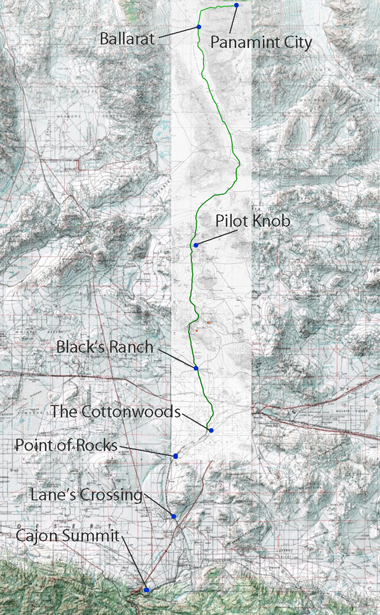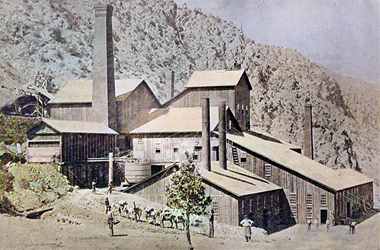Part-time Prospector
Road to the Panamint Mines
It was during this time that a fabulously rich strike of silver ore was found in Surprise Canyon in the Panamint Mountains north of the San Bernardino County line. This is west of Death Valley, and the location is so remote that, according to historian Burr Belden, "it would be difficult to conceive of a more inaccessible place."The area was ideal as a hideaway for outlaws, and it became a regular robbers' roost. Belden states that the veteran express firm, Wells Fargo & Co., was asked to provide a stage to Panamint, but when their agent went out to check the area, he recognized several of the "first settlers," and for the only time in mining camp history the company refused its services.
While searching for a proper supply route to their burgeoning mining town, the owners of the principal Panamint mines noticed an aggressive San Bernardino firm, Meyerstein & Co., which was supplying goods. One of the mine owners was United States Senator William M. Stewart of Nevada, and it was he who approached Caesar Meyerstein with the proposition that the San Bernardino merchants establish a stage line to Panamint. The proposal was accepted, and in the early fall of 1874, preparations for the construction of a road from Cottonwoods to the Panamints were underway.
With Senator Stewart aggressively promoting this road, things moved along quite rapidly. The County Board of Supervisors created a new road district for the desert, and appointed Aaron Lane as road overseer. The position of road overseer was a job of some importance in the county; the individual in charge had virtually all authority over the selection of the route and over the actual construction of the road itself. In September the Weekly Argus ran a lengthy article describing the creation and the boundaries of the district, and concluded by quoting the directives issued by the Board of Supervisors:
-
This said district to be known by the name of Mojave district, and
A. G. Lane
is appointed overseer of said district and the clerk is ordered to issue his commission as such, and the said overseer is hereby directed to lay out on the most practicable route from the Cottonwoods on the
Mojave river
to where the San Bernardino county road to Panamint crosses the
Inyo
and San Bernardino county line a road, which is hereby declared a public road.
California at that time was widely anti-Chinese, and the town of San Bernardino was extremely so. Practically every issue of the newspapers in the mid-1870s carried some item about the Chinese, usually very negative. How Lane handled the situation with the miners the papers do not say, but he must have persuaded them to rethink their position, because the road was completed within a few weeks.
According to one reporter, a good many citizens of San Bernardino eagerly anticipated the commercial opportunities the new road would provide:
-
We learn, from a gentleman in from San Bernardino this morning, that Captain Lane, of
Lane's Crossing
of the Mohave, has been appointed
by the Board of Supervisors of that county, Roadmaster; and that on Saturday he went out, with a large gang of Chinamen, to place the
road leading to Panamint in perfect condition.
Every wagon and team in San Bernardino has been pressed into the service of meeting the emergency of transporting freights to Panamint, and immense supplies of corn, grain, etc., are being purchased. All these things have the effect of making the San Bernardino mind exceedingly jubilant.
The County Board of Supervisors was not quite as generous in its appraisal of the job done, and after considering Lane's bill for $645.61, allowed only $500. This amount seems like a bargain for 115 miles of road, but without knowing what expenses were included in the bill, it is difficult to say whether the Board was overly stingy. It was quite common for the Supervisors to reject a portion of a bill that had been submitted, and Lane may have allowed for this.
< Previous - Next >

Panamint City

-=-